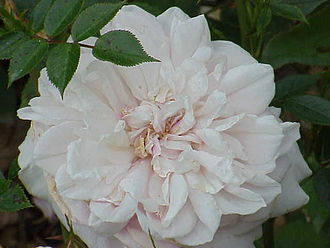In 1799 while Napoleon was in Egypt, Josephine purchased the Chateau de Malmaison.[20] She had it landscaped in an “English” style, hiring landscapers and horticulturalists from the United Kingdom. These included: Thomas Blaikie, a Scottish horticultural expert, another Scottish gardener, Alexander Howatson, the botanist, Ventenat, and the horticulturist, Andre Dupont. The rose garden was begun soon after purchase; inspired by Dupont’s love of roses. Josephine took a personal interest in the gardens and the roses, and learned a great deal about botany and horticulture from her staff. Josephine wanted to collect all known roses so Napoleon ordered his warship commanders to search all seized vessels for plants to be forwarded to Malmaison. Pierre-Joseph Redouté was commissioned by her to paint the flowers from her gardens. Les Roses was published 1817-20 with 168 plates of roses; 75-80 of the roses grew at Malmaison. The English nurseryman Kennedy was a major supplier, despite England and France being at war, his shipments were allowed to cross blockades. Specifically, when Hume’s Blush Tea-Scented China was imported to England from China, the British and French Admiralties made arrangements in 1810 for specimens to cross naval blockades for Josephine’s garden.[21] Sir Joseph Banks, Director of the Royal Botanical Gardens, Kew, also sent her roses. The general assumption is that she had about 250 roses in her garden when she died in 1814. Unfortunately the roses were not catalogued during her tenure. There may have been only 197 rose varieties in existence in 1814, according to calculations by Jules Gravereaux of Roseraie de l’Haye. There were 12 species, about 40 centifolias, mosses and damasks, 20 Bengals, and about 100 gallicas. The botanist Claude Antoine Thory, who wrote the descriptions for Redouté’s paintings in Les Roses, noted that Josephine’s Bengal rose R. indica had black spots on it.[22] She produced the first written history of the cultivation of roses, and is believed to have hosted the first rose exhibition, in 1810.[23]
Modern hybridization of roses through artificial, controlled pollination began with Josephine’s horticulturalist Andre Dupont.[20] Prior to this, most new rose cultivars were spontaneous mutations or accidental, bee-induced hybrids, and appeared rarely. With controlled pollination, the appearance of new cultivars grew exponentially. Of the roughly 200 types of roses known to Josephine, Dupont had created 25 while in her employ. Subsequent French hybridizers created over 1000 new rose cultivars in the 30 years following Josephine's death. In 1910, less than 100 years after her death, there were about 8000 rose types in Gravereaux's garden. Bechtel also feels that the popularity of roses as garden plants was boosted by Josephine’s patronage. She was a popular ruler and fashionable people copied her.
| Styles of Empress Joséphine of the Frenchas consort | |
|---|---|
 | |
| Reference style | Her Imperial Majesty |
| Spoken style | Your Imperial Majesty |
| Alternative style | Madame |
Brenner and Scanniello call her the "Godmother of modern rosomaniacs" and attribute her with our modern style of vernacular cultivar names as opposed to Latinized, pseudo-scientific cultivar names. For instance, R. alba incarnata became "Cuisse de Nymphe Emue" in her garden. After Josephine’s death in 1814 the house was vacant at times, the garden and house ransacked and vandalised, and the garden’s remains were destroyed in a battle in 1870. The roseSouvenir de la Malmaison appeared in 1844, 30 years after her death, named in her honor by a Russian Grand Duke planting one of the first specimens in the Imperial Garden in St. Petersburg.[22] from Wikipedia






No comments:
Post a Comment